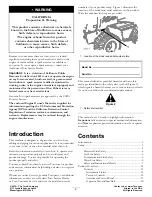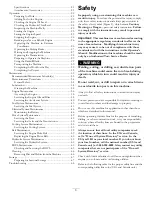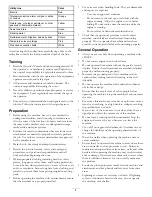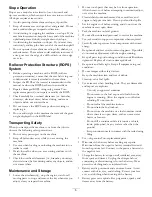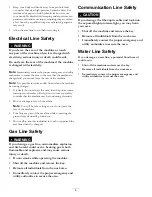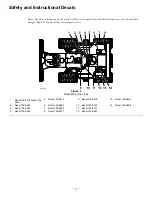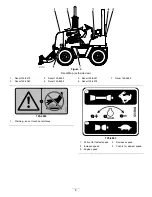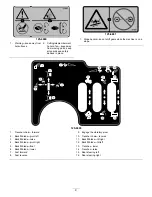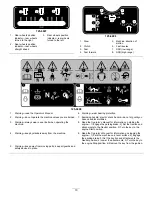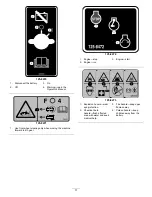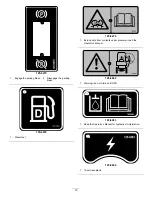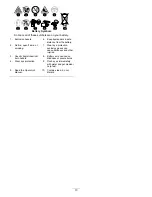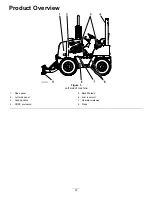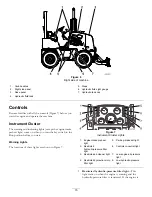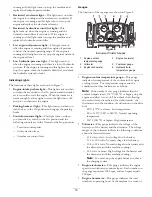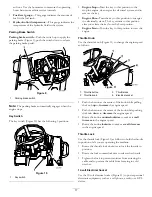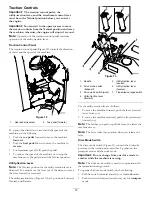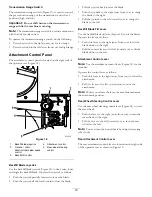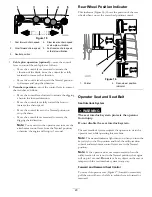
Slope Operation
Slopes are a major factor related to loss-of-control and
tip-over accidents, which can result in severe injury or death.
All slopes require extra caution.
•
Avoid operating this machine on slopes, if possible.
•
Keep all movements on slopes slow and gradual. Do not
make sudden changes in speed or direction.
•
Avoid starting or stopping the machine on a slope. If the
machine loses traction, keep the heavy end of the machine
uphill and proceed slowly, straight down the slope.
•
Avoid turning the machine on slopes. If you must turn,
turn slowly and keep the heavy end of the machine uphill.
•
Do not operate the machine near drop-offs, ditches, or
embankments. The machine could suddenly turn over if
a tire goes over the edge of a cliff or ditch, or if an edge
caves in.
Rollover Protection Structure (ROPS)
System
•
Before operating a machine with a ROPS (rollover
protection structure), ensure that the seat belt is in good
condition and is securely attached to the machine.
•
Inspect the ROPS at the interval recommended in this
manual or when the ROPS has been in an accident.
•
Repair a damaged ROPS using only genuine Toro
replacement parts; do not repair or modify the ROPS.
•
Check carefully for overhead clearances (i.e. branches,
doorways, electrical wires) before driving under any
objects and do not contact them.
•
Do not remove the ROPS except when servicing or
replacing it.
•
Do not add weight to the machine that exceeds the gross
weight displayed on the ROPS label.
Transporting Safety
When you transport the machine to or from the job site,
observe the following safety precautions:
•
Do not carry passengers on the machine.
•
Keep all bystanders away while you are moving the
machine.
•
Use care when loading or unloading the machine into a
trailer or truck.
•
Watch for traffic when you are crossing roadways with
the machine.
•
Check for overhead clearances (i.e., branches, doorways,
electrical wires) before driving under any objects, and do
not contact them.
Maintenance and Storage
•
Lower the attachment(s), stop the engine, wait for all
moving parts to stop, and remove the key whenever you
adjust, clean, or repair the machine.
•
Do not touch parts that may be hot from operation.
Allow them to cool before attempting to maintain, adjust,
or service the machine.
•
Clean debris from attachments, drives, mufflers, and
engine to help prevent fires. Clean up oil and fuel spills.
•
Let the engine cool before storing, and do not store the
machine near an open flame.
•
Park the machine on level ground.
•
Do not allow untrained personnel to service the machine.
•
Use jack stands to support components when required.
•
Carefully release pressure from components with stored
energy.
•
Keep hands and feet away from moving parts. If possible,
do not make adjustments with the engine running.
•
Keep all parts in good working condition and all hardware
tightened. Replace all worn or damaged decals.
•
Keep nuts and bolts tight. Keep all equipment in good
condition.
•
Do not tamper with safety devices.
•
Keep the machine clean and free of debris.
•
Clean up oil or fuel spills.
•
Use extra care when handling fuels. They are flammable
and vapors are explosive.
–
Use only an approved container.
–
Do not remove the fuel cap or add fuel when the
engine is running. Allow the engine to cool before
refueling. Do not smoke.
–
Do not refuel the machine indoors.
–
Do not drain the fuel indoors.
–
Do not store the machine or a fuel container inside
where there is an open flame, such as near a water
heater or furnace.
–
Do not fill a container while it is inside a vehicle,
trunk, pickup bed, or any surface other than the
ground.
–
Keep container nozzle in contact with the tank during
filling.
•
Use only genuine Toro replacement parts.
•
Disconnect the battery before making any repairs.
Disconnect from the negative battery terminal first and
from the positive last. Connect to the positive first and to
the negative last.
•
Charge the battery in an open well ventilated area, away
from spark and flames. Unplug the charger before
connecting or disconnecting it from the battery. Wear
protective clothing and use insulated tools.
•
Battery acid is poisonous and can cause burns. Avoid
contact with skin, eyes, and clothing. Protect your face,
eyes, and clothing when working with a battery.
•
Battery gases can explode. Keep cigarettes, sparks, and
flames away from the battery.
5
Содержание RT600
Страница 71: ...Notes 71...


